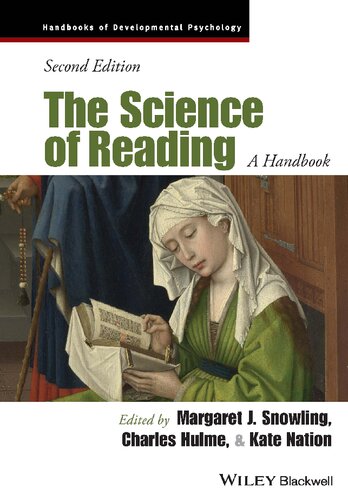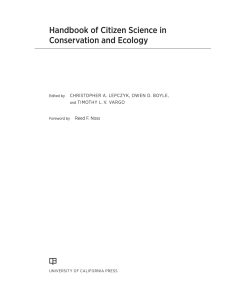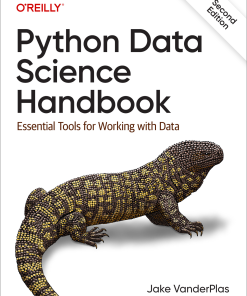The Science of Reading A Handbook 2nd Edition by Margaret Snowling, Charles Hulme, Kate Nation ISBN 1119705134 9781119705130
$50.00 Original price was: $50.00.$25.00Current price is: $25.00.
The Science of Reading: A Handbook 2nd Edition by Margaret J. Snowling, Charles Hulme, Kate Nation – Ebook PDF Instant Download/Delivery: 1119705134, 9781119705130
Full download The Science of Reading: A Handbook 2nd Edition after payment
Product details:
ISBN 10: 1119705134
ISBN 13: 9781119705130
Author: Margaret J. Snowling, Charles Hulme, Kate Nation
The Science of Reading: A Handbook 2nd Edition: d
The Science of Reading: A Handbook 2nd Edition Table of contents:
PART I: Word Recognition
-
CHAPTER ONE: Progress in Reading Science
- Reading and Reading Science in Historical Context
- Advance 1: The Word‐identification System in Skilled Alphabetic Reading
- Advance 2. Comprehending while Reading
- Advance 3. Toward a More Universal Science of Reading
- Concluding Reflections: Learning to Read and Reading Pedagogy
- References
-
CHAPTER TWO: Models of Word Reading
- Reading Aloud: Accounting for Basic Phenomena
- Simulations of Behavioral Studies: What Did They Show?
- Nonword Pronunciation
- Summary
- Hybrid Models
- Learning to Read
- Conclusions
- Acknowledgments
- References
-
CHAPTER THREE: Word Recognition I
- Letter‐Based Word Recognition
- Orthographic Processing and Word Recognition
- Bridging the Gap with Sentence Reading
- Conclusions
- Acknowledgments
- References
-
CHAPTER FOUR: Word Recognition II
- Evidence that Phonology Is Involved in Silent Reading
- Computational Models of Visual Word Recognition
- Phonology, Reading, and Neuroscientific Findings
- Conclusions
- References
-
CHAPTER FIVE: Word Recognition III
- Morphemes as “Islands of Regularity”
- Morphology and the Spelling‐Meaning Mapping
- Morphological Analysis in Skilled Reading
- Theoretical Accounts of Morphological Processing
- Mechanisms for Acquiring Morphological Knowledge
- Conclusions and Emerging Questions
- References
PART II: Learning to Read and Spell
-
CHAPTER SIX: The Foundations of Literacy
- Precursors to Literacy
- Language Input
- The Home Literacy Environment
- The Limiting Environment
- Complex Linguistic Contexts
- Summary and Conclusions
- References
-
CHAPTER SEVEN: Learning to Read Words
- What Needs to Be Learned for Skilled Word Reading?
- Sublexical‐Level Learning
- Lexical‐Level Learning
- Interactions between Sublexical and Lexical Learning
- Conclusions and Future Directions
- Acknowledgments
- References
-
CHAPTER EIGHT: Learning to Spell Words
- Writing Systems
- Elements of Children’s Spelling Development
- Beyond Simple Phonological Patterns
- Children’s Spelling in the Digital Age
- Theories of Spelling Development
- Spelling and Developmental Disabilities
- Implications for Instruction
- Future Directions
- References
-
CHAPTER NINE: Individual Differences in Learning to Read Words
- Methodological Approaches
- Child‐ and Word‐Level Predictors of Individual Differences
- Word‐Level Predictors
- Child‐by‐Word Predictors
- Conclusions
- Acknowledgments
- References
-
CHAPTER TEN: Teaching Children to Read
- How Best to Teach Decoding in Whole‐Class Settings?
- Teaching Children with Reading Difficulties
- Conclusions
- References
PART III: Reading Comprehension
-
CHAPTER ELEVEN: Reading Comprehension I
- A Brief History of Models of Discourse Comprehension
- A Comprehensive Model of Discourse Comprehension
- Current Research Issues
- Concluding Remarks
- References
-
CHAPTER TWELVE: Reading Comprehension II
- Eye Movements and Reading
- Conclusions
- Acknowledgments
- References
-
CHAPTER THIRTEEN: Modeling the Development of Reading Comprehension
- Theoretical Foundations for Reading Comprehension Development
- Understanding the Development of Reading Comprehension – Methodological Considerations
- Understanding the Development of Reading Comprehension – What Do We Know?
- Is the Simple View of Reading Too Simple?
- The Simple View of Reading – Simple but Complex
- Relationships between Longitudinal Studies and Theories of Reading Development
- Future Directions
- References
-
CHAPTER FOURTEEN: Children’s Reading Comprehension Difficulties
- A Framework for the Study of Reading Comprehension Difficulties
- Identification and Prevalence of Poor Comprehenders
- The Identification of Poor Comprehenders: Variation in Selection and Group Matching
- The Measurement of Reading Comprehension: The Nature and Effect of Differences among (Standardized) Assessments
- Sources of Reading Comprehension Difficulty
- The Dynamics of Language and Literacy Development over Time
- Conclusions and Future Directions
- References
PART IV: Reading in Different Languages
-
CHAPTER FIFTEEN: Reading and Reading Disorders in Alphabetic Orthographies
- Characteristics of Alphabetic Orthographies
- Models of Word Reading
- Skilled Word Reading in Alphabetic Orthographies
- Reading Development in Alphabetic Orthographies
- References
-
CHAPTER SIXTEEN: Reading and Reading Disorders in Chinese
- Chinese Language(s)
- Chinese Script(s)
- All Chinese Is Not Alike
- Predictors of Individual Differences in Learning to Read
- Spelling Skills
- Instruction and Remediation for Word Recognition
- Reading Comprehension in Chinese
- Conclusions and Next Steps
- Correspondence
- Acknowledgments
- References
-
CHAPTER SEVENTEEN: Reading the Akshara Writing System
- The Akshara Writing System
- Reading Development
- Intra‐symbol features
- Reading Development: Word Decoding
- Conclusions
- References
PART V: Disorders of Reading
-
CHAPTER EIGHTEEN: Acquired Disorders of Reading and Writing
- Acquired Disorders of Reading and Writing
- Pure Alexia/Letter‐by‐Letter Reading
- Surface Dyslexia
- Phonological Dyslexia
- Deep Dyslexia
- Concluding Comments
- References
-
CHAPTER NINETEEN: Developmental Dyslexia
- Developmental Dyslexia
- Definition of Developmental Dyslexia
- Common Features of Dyslexia
- Prevalence of Developmental Dyslexia
- Sex Differences in Developmental Dyslexia
- Common Co‐Occurring Conditions
- Operational Definitions of Dyslexia
- Multifactor Models
- Leveraging Developmental Research Methodologies to Advance Understanding about Dyslexia
- Screening for Early Identification
- The Role of Assistive Technology for Individuals with Dyslexia
- Improving Operational Definitions
- Acknowledgments
- References
-
CHAPTER TWENTY: Comorbidity of Reading Disorders
- Comorbidity of Dyslexia and Co‐Occurring Disorders
- Prevalence of Dyslexia Comorbidities
- Models of Dyslexia
- Models of Comorbidity
- Comorbidities between Dyslexia and Other Neurodevelopmental Disorders
- Clinical and Educational Implications
- References
-
CHAPTER TWENTY ONE: Learning to Read with a Language or Hearing Impairment
- The Language Basis of Reading
- Children with Language Impairment: Who Are They?
- Reading Development in Children with Language Impairment
- Children with Hearing Loss
- Summary and Conclusions
- References
PART VI: Biological and Social Correlates of Reading
-
CHAPTER TWENTY TWO: The Genetics of Dyslexia
- Dyslexia Is a Complex Phenotype
- Reading Abilities are Highly Heritable
- Searching for “Dyslexia Genes”
- From Genes to Function: Neuronal Migration and Cilia
- The GWAS Era
- GWAS for Dyslexia and Reading Abilities
- Rare Variants
- Polygenic Risk Scores
- Conclusions
- Acknowledgments
- References
-
CHAPTER TWENTY THREE: Genetic and Environmental Influences on Learning to Read
- Overview of Behavior Genetic Methods
- Genetic and Environmental Influences on Reading
- Reading (Dis)ability
- Multivariate Analyses
- Developmental Studies
- Specific Environments and Gene‐Environment Interplay
- Conclusion and Future Directions
- References
-
CHAPTER TWENTY FOUR: The Neurobiology of Literacy
- The Methods of Modern Neuroscience
- The Neural Circuitry of Skilled Reading
- Development of the Brain’s Reading Circuitry
- Neurobiological Differences in Developmental Dyslexia
- Conclusions
People also search for The Science of Reading: A Handbook 2nd Edition:
what is the science of reading approach
the science of reading pdf
the science of reading curriculum
books about the science of reading
components of the science of reading
Tags:
Margaret Snowling,Charles Hulme,Kate Nation,Science,Reading,Handbook
You may also like…
Politics & Philosophy - Ancient & Medieval Philosophy
The Bloomsbury Handbook of Plato 2nd Edition Gerald A. Press (Eds.)
Biology and other natural sciences - Ecology
Handbook of Citizen Science in Conservation and Ecology Christopher A. Lepczyk
Computers - Programming
Medicine - Neurology
Reading EEGs A Practical Approach 2nd Edition by L. John Greenfield Jr. 9781975121211 197512121X
Engineering - Chemical Engineering
Handbook of Petrochemicals Production 2nd Edition Robert A. Meyers
Politics & Philosophy - Social Sciences
Handbook Of Security Science 1st Edition by Anthony J. Masys 9783319918747 3319918745
Computers - Programming
History - Asian History
Routledge Handbook of Contemporary India, 2nd Edition Knut A. Jacobsen












